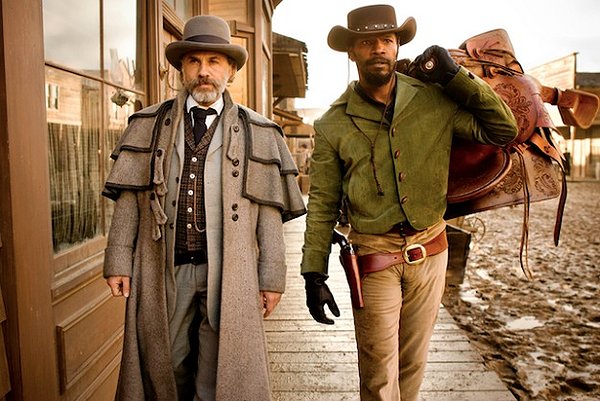Django Unchained
Written and Directed by: Quentin Tarantino
Starring: Jamie Foxx, Christoph Waltz, Leonardo DiCaprio, Kerry Washington, Samuel L. Jackson
Rated: R for strong graphic violence throughout, a vicious fight, language and some nudity
“Django Unchained” is, on its surface, a fairly straightforward “man is wronged and loses his woman, then meets a man who helps him achieve his quest to avenge himself and get his woman back” sort of story. It’s certainly easy to enjoy the film on that level, especially if you’re a fan of Quentin Tarantino’s violent, over-the-top style. However, there are also layers of character development, complex themes, and enough references to fill a book. This is a movie that seems destined to spawn art student theses, not just a Western set in the South.
Django (Jamie Foxx) is a slave who’s been branded as a runaway and sold to a different owner than his wife as punishment for their attempt to escape. When a roving bounty hunter, Dr. Schultz (Christoph Waltz), buys him because he can identify Schultz’s current targets, he finds himself with an opportunity to get revenge and rescue his wife. Foxx brings a weariness and rage to the part that raises his character out of the cookie-cutter-stereotype he’s based in and makes him a person we can care about and really empathize with.
Anyone who’s seen “Inglourious Basterds” knows that Waltz is a delightfully sly scene-stealer, and if you loved him there, you’ll love him here. His Schultz has a sense of humor, delights in the ridiculous, and is also a master sharpshooter completely untroubled by his grisly trade. He trains Django to be a bounty hunter after giving him his freedom, and decides to help the former slave on his quest. They make a strange pair, but Foxx and Schultz have the necessary buddy chemistry to make it work: Django is as bemused by Schultz as we are.
Django and Schultz’s quest takes them to the home of Monsieur Candie (Leonardo DiCaprio), the thoroughly evil man who owns one of the largest plantations in the South. His casual cruelty (including having a runaway torn to bits by dogs in front of his guests — and the audience) to slaves is nothing new to Django but horrifies Schultz, and seems designed to horrify viewers as well. Of course, anyone who’s studied the period knows how awful slave-owners could be to the people they considered their subhuman property, but seeing it on a screen in full color, screams and all, is something else.
What many people will likely find more difficult to bear than the gruesome violence is the characterization of the villains and the regular folks who are background characters. For one thing, there’s the language — not the swearing (of which there is plenty), but the liberal use of the various historically-authentic terms for black people. DiCaprio’s character, in one deeply disconcerting scene, muses on the subhuman, submissive nature of black people and then prepares to split a slave girl’s head open to demonstrate his theory with phrenology. This is not a film for the faint of heart in a number of ways.
If “Django” has one weakness, it’s a tendency for dramatic pauses and long reaction shots that some may find annoying. Its pacing is fine, thankfully, but its just-over-three-hour runtime will feel longer if you don’t like long shots.
Of all Tarantino’s films, “Django Unchained” is most reminiscent for me of “Inglourious Basterds,” and not just because of Waltz’s presence. Both are essentially wish-fulfillment (who doesn’t want to see a slave get free and kill some evil white slavers in a huge gunfight complete with anachronistic dynamite?) , but with a generous helping of violent sequences and dialogue meant to make us uncomfortable, meant to make us think. Tarantino is maturing more and more as a filmmaker, and it’s a pleasure to watch, at least for those who are okay with the discomfort.
